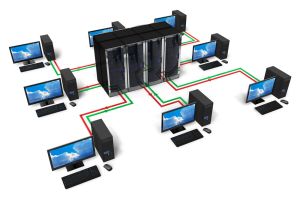Internet of Things: How Telecoms Can Adjust to Meet New Data Realities
 The rapid development of the Internet of Things (IoT) has left many companies scrambling, trying to adapt to the explosive volumes of data that just weren’t predicted (or even imagined) 5-10 years ago. Infrastructures that were designed with maximum anticipated load usage back then simply aren’t prepared to meet growing IoT demands.
The rapid development of the Internet of Things (IoT) has left many companies scrambling, trying to adapt to the explosive volumes of data that just weren’t predicted (or even imagined) 5-10 years ago. Infrastructures that were designed with maximum anticipated load usage back then simply aren’t prepared to meet growing IoT demands.
In fact, many experts now speculate that by the year 2020 there will be more than 50 million connected devices forming the Internet of Things. And although that amount may seem staggering, with constant innovation taking place in the form of wearable mobile technology and smart everything—from cars to coffee pots—that number may end up looking like a mere drop in the ocean.
This situation is especially relevant for network operators in the telecom industry. Surging amounts of data coming in and the various new ways that business users need to analyze and access that information is placing a huge strain on systems. And typically, call centers are valiantly trying to cope with massive CDRs (call data records) from increased device connectivity and usage requirements.
Advantages of Adaptation
A major advantage to the Internet of Things is the capacity to analyze vast quantities of data in relation to patterns and other actionable information. However, this necessitates being able to store huge volumes of historical data for lengthy times frames.
And if database infrastructure and analytics are adapted appropriately, the competitive advantages include a host of customer service improvements such as:
- The inclusion of value-added and customized services through enhanced analytics
- Isolating patterns in archived CDRs to identify service issues and allow alterations in network configurations designed to eliminate them
- Identifying the similarities in usage patterns and service tickets to develop new offers and targeted marketing plans
Strategies for Adaptation
Adapting to the sheer volume of data engendered by the Internet of Things involves strategic planning. Employing innovative approaches to data analytical infrastructure design will help to position telecoms, and their service providers, with the flexibility necessary to meet current and upcoming IoT challenges.
A traditional approach would involve investing in a monolithic relational database, but this type of solution is little more than a temporary fix. Specialized technologies such as cloud-based ad-hoc analytics and real-time investigative database structures (like RAID) offer functional solutions for the hefty network loads present with the IoT. Being able to mine large quantities of records quickly and efficiently will allow operators to identify and react to network issues swiftly, as well as troubleshoot possible situations on an ad-hoc basis.
Possible network issues include:
- Problems with various factors captured in call records such as voice, video, or data transmissions
- Performance functionality of certain device types, operating systems, browsers, or applications
- Communication technology, i.e 4G, LTE
Thinking about database infrastructure and analytics in new ways will help telecoms adapt to the incredible opportunities created by the Internet of Things.
Three Critical Infrastructure Elements for Network Uptime
 In today’s fast-paced world, where business is increasingly conducted electronically, infrastructure reliability and network up-time are crucial. Infrastructure weaknesses can lead to network downtime, and outages can prove costly for businesses.
In today’s fast-paced world, where business is increasingly conducted electronically, infrastructure reliability and network up-time are crucial. Infrastructure weaknesses can lead to network downtime, and outages can prove costly for businesses.
Network uptime can be affected by three primary factors. Focusing on adding redundancy to these three elements can help ensure network reliability and decrease the likelihood of an outage.
Overheating
Servers, like any piece of equipment, have the potential to overheat if proper steps are not taken to control their temperature. Servers typically run uninterrupted, unlike desktop PCs that are powered down, or go into idle mode throughout the day. Servers also are often housed in small rooms, and in close quarters with other network equipment. These server rooms can quickly warm to levels that can jeopardize equipment.
Whether a business is housing its own equipment, or outsourcing network and server functions to a third party or cloud provider, it is critical to ensure that network infrastructure is properly cooled. At least two cooling methods should be employed to ensure there is a backup in case one cooling method fails. Possible cooling solutions include rooftop air conditioning units, external condensers, and computer room air conditioning units.
Power Failures
Sometimes the most obvious point of weakness is the most overlooked. Infrastructure equipment requires power to function, and reliable data center power with a backup power solution for redundancy is critical.
An A+B power feed, which creates two independent channels from the public power source to the infrastructure equipment, should be at the top of the requirement list for data center power. This eliminates potential single points of failure when power channels are shared at any point.
Some of the power options that can be included in each feed are uninterruptible power supply, utility power, back-up generator, maintenance bypass panel, internal server power, mains distribution panel, and an automatic transfer switch. Each power feed should have at least one of these options, and should be able to handle the entire server load at peak usage independently to create redundancy.
Network Connections
The equipment used to connect infrastructure to the Internet is another potential point of weakness. Routers and switches wear out relatively quickly, and should be properly maintained and replaced in a timely manner. Integrating backup connections to create redundancy can help prevent network downtime. In addition, connections from the data center to the external Internet network are crucial for network uptime. Peering arrangements with multiple connections create redundancy and reliability, and can optimize performance.
Another important key to making sure potential network failure is mitigated is to choose network and infrastructure providers that are committed to reducing or eliminating single points of failure by adding backups and redundancies. Network downtime is costly and unacceptable, but there are simple ways to build in redundancy. Cutting corners on infrastructure reliability leads to network downtime and service interruptions that can ultimately cost more than building redundancy in from outset.
Keeping Your Business Secure While Using an IaaS Plan
 Infrastructure-as-a-Service (IaaS) plans benefit a business by offering access to a cloud-based infrastructure that is tailored to their specific needs. However, many businesses are concerned with keeping their data safe with IaaS.
Infrastructure-as-a-Service (IaaS) plans benefit a business by offering access to a cloud-based infrastructure that is tailored to their specific needs. However, many businesses are concerned with keeping their data safe with IaaS.
When subscribing to an IaaS plan, here’s how businesses can protect their sensitive data.
Awareness of What a Business Controls
Business users who subscribe to an IaaS plan should be aware of exactly what their plan entails. This includes the configuration of the infrastructure and how users will be able to access different data. By being aware of what they need to control, businesses will be knowledgeable and informed about the security of their plan.
Ownership
It’s important to know who owns the data within the infrastructure. Understanding ownership details enables a business to navigate logistical situations and protect the organization against legal factors.
The Service Level Agreement
By understanding the Service Level Agreement (SLA), businesses help protect their data and intellectual property. An SLA is a fluid document and should be treated as such.
Complying With Regulations
In order to keep their IaaS secure, businesses need to be aware of industry regulations. Businesses should ensure that their IaaS provider is willing and able to work with them to fine-tune the management of processes and configuration capabilities.
User Authentication
Cloud hosting plans are completely virtual and not necessarily hosted within an organization, which means end user authentication can present a high security risk. Employees should keep login credentials private and be properly trained in authentication best practices. This doesn’t mean that end users should be inconvenienced or restricted; technology leaders should lead by example when establishing best practices, and businesses should find the balance between security and convenience for their users.
Monitor the Network
Even with the best security in the world, a business may run into issues with their IaaS if network monitoring is lacking. It is important to know and understand the network in order to catch unauthorized activity before it turns into a security breach. Monitoring the wireless infrastructure — especially as many users are now employing mobile devices to connect — will also prevent unauthorized users from accessing the cloud.
Employee Training
Employees aren’t always aware of how security holes can be created. Something as simple as accessing the infrastructure through a public Wi-Fi hotspot can create major security risks. Businesses can easily reduce these risks by training employees to understand how best to keep their connection secure.
Data Backup
Businesses must be aware of how their IaaS provider handles data backups, especially if using a new provider. Understanding the vendor’s redundancy procedures and being able to take action allows a business to protect their assets.
Data in Transit
Data moving between users, the data center, and the location of the IaaS systems can come under attack in different ways. In order to enhance security as much as possible, businesses must understand how this data moves.
Internal Unauthorized Activities
Users with authorization might still perform unauthorized activities. As well as ensuring that employees understand best practices, businesses should also ensure that the IaaS vendor has professional staff members and can control potential internal issues.
IaaS vendors assists with security strategies, but it never hurts for a business to have their own plans in place. By understanding their plan, monitoring their network, and ensuring that all staff members follow best practices, businesses have the ability to data safe.
How Cloud Computing Benefits Start-Ups and Small Businesses
 As recently as a few years ago, entrepreneurs requiring computing solutions would have had little choice other than to make major IT investments. However, the advent of the cloud has changed the playing field, both for business owners and their customers.
As recently as a few years ago, entrepreneurs requiring computing solutions would have had little choice other than to make major IT investments. However, the advent of the cloud has changed the playing field, both for business owners and their customers.
Recent studies have quantified the impact cloud computing has had on global businesses; according to Gartner, a leading market research firm, cloud computing services generated over $150 billion in revenues in 2014.
The cloud offers a convenient and cost-effective alternative to traditional IT delivery methods, allowing entrepreneurs to access and customize software programs, data storage and backup services, and a wide range of other specialized functions and applications over the Internet.
Major benefits of the cloud include:
- Significant cost reductions – Cloud solutions reduce the need to purchase in-house hardware and software. The cloud also eliminates the need for physical storage and backup of files and documents.
- Scalability and flexibility – Cloud technologies can be upsized or downsized according to the changing needs of a business.
- IT savings – Cloud-based applications reduce resource or eliminate demands on in-house IT departments.
Cloud Computing Deployment Methods
Businesses seeking to take advantage of cloud computing have four main deployment methods available:
- Public cloud – This deployment model is easily accessible, hosted on the World Wide Web.
- Private cloud – Companies can create private clouds behind firewalls for added security.
- Community cloud – This model is a partnership of companies or organizations sharing the same private cloud space.
- Hybrid cloud – An emerging deployment approach that combines aspects of the private, public, and community cloud models, creating a customized, flexible solution.
Business Functions Supported by Cloud Computing
Cloud computing has a wide range of applications in the business world, but there are four primary ways in which the technology is used:
- File storage and data backup – Cloud computing has emerged as the most flexible and convenient way to store files and back up important data. The remote storage of digital documents frees up much-needed space on local devices. Cloud technologies also offer secure data backup capabilities, ensuring business continuity in the event of a disruption.
- Collaboration – Cloud computing has transformed the workplace, making it much easier for people working from different or remote locations to communicate, collaborate and share information. Roughly two-thirds of small and medium-sized enterprises report the need for employees to be able to work anytime, from anywhere. For businesses such as these, cloud solutions offer a major boost to productivity and operational efficiency.
- Resource accessibility – Software, data, and documents stored in the cloud are quickly and easily accessible. Server management is monitored by cloud providers, further liberating businesses from administrative costs.
- Effective management of business growth – In the past, growth forced businesses to make further investments in IT resources. Now, the near-instant scalability of the cloud provides flexible, cost effective computing resources.
How to Choose a Cloud Provider
Businesses should carefully assess cloud providers based on terms, pricing, and service level agreements, as well as security and reputation. Many providers offer low-cost trial periods, which businesses can take advantage of to test compatibility.
It’s important to make a thorough needs assessment in partnership with providers. Topics to address should include:
- The best deployment model
- Security needs
- Software, infrastructure, and platform requirements
- The availability of new applications
- Merging existing IT infrastructure with the cloud environment
The cloud offers a scalable, flexible, affordable route to improved IT performance that is ideal for businesses with limited IT resources.
Debunking Common Virtual Security Myths
 When it comes to deploying security in a virtual environment, some industry professionals draw a blank–or, worse, they think that it’s necessary to replace existing physical security protocols with virtual substitutes. This is not true.
When it comes to deploying security in a virtual environment, some industry professionals draw a blank–or, worse, they think that it’s necessary to replace existing physical security protocols with virtual substitutes. This is not true.
In fact, the best approach to use when viewing virtual security is a logical one. Consider this: A jewelry store owner who expands the physical location or who opens a new facility would not try to use his/her current security force to protect the new location, nor would the owner secure the new location by trying to stretch the current security force between two facilities and simply hope that the depleted resources will cover the need. Both sites need to be secure.
Considering the current, overwhelming surge in virtual as-a-service solutions, knowing how and when to apply virtual security measures like firewalls has become a crucial consideration for businesses. This is especially due to the fact that according to industry specialists, over one-fifth of all VPN (virtual private network) security will be deployed in a virtual format by the end of the year.
Layered Security
Companies already understand the flexibility and cost-saving advantages of moving information and even key infrastructure to the cloud (hence, the rapid growth). That said, virtual security protocols should not be an either/or dilemma; they should be employed in a layered defense. The physical systems already in place should be supported with virtual firewalls—not replaced with them—depending on the level of the workload requirements.
The reasons for this layered defense are abundant. Not only does it secure the virtual aspects of the data system, but the same ease of alteration and on-demand access that is available in a virtual environment is accessible with virtual firewalls. Companies can adjust deployment according to specific needs, which allows them to better control financial commitments.
Deployment Confusion
The issue of deployment confusion has been discussed at length by industry experts. Keeping pace with the rapidly expanding network services available in a virtual environment means finding ways to secure that activity from threats.
Therefore, deployment should depend on the same workload and accessibility requirements that have determined the current physical security measures.
Notably, there are two basic types of virtual firewalls:
- Introspective: This type resides within the hypervisor side of each virtual NIC (network interface card). Although it offers a well-managed way to keep virtual machines protected, it is limited in availability at this time.
- Edge: This is the most common form of virtual firewalls. These reside between two or more virtual portgroups or switches. The beneficial aspect of this type of virtual security is that companies can deploy them at the “edge” of their data center or between trust zones in a cloud environment, depending on their workload and throughput activity.
Rules of the Game
In general, there are three fundamental rules when it comes to adding virtual security services to a network:
- Deploy virtual firewalls to enhance the depth of network safety in conjunction with the physical securities already in place.
- Know the specifications of a virtual firewall. (The specs for physical firewalls are outlined; virtual ones should be outlined, too.)
- Don’t limit virtual security to one type (or breed) of firewall. (Requirements play an essential role in the types and amount of firewall protection needed for a network.)
With the changing environment of virtual services, companies can discover the best means of keeping their networks secure by incorporating virtual security protocols. The investment is well worth it when the risks are considered, and the faster, more adaptive role that these protocols play can make a huge difference in security compliance.
